Aircraft FAGE Fieldwork

The aircraft FAGE instrument, designed to make measurements of OH and HO2 radicals in the free troposphere, has been operational since 2004, when it was first deployed on the BAe146 FAAM Research aircraft (pictured above). In 2007 the instrument was modified to detect IO radicals and took part in the RHaMBLe project, making ship-borne measurements of the radical in the mid-Atlantic ocean (see IO measurements). The instrument has also been used in a ground based configuration to measure OH and HO2 as part of the Seasonal Oxidant Study (SOS) at the Cape Verde Observatory in 2009 (see Ground-based measurements). The aircraft instrument was used in the IO configuration for ship-based measurements during the Stratospheric Ozone: Impacts of Halogens in a Varying Atmosphere (SHIVA) project in South East Asia in 2011 (see IO measurements).
Selected details of aircraft measurements can be found below.
RONOCO: UK, 2010-2011 and SeptEx: UK, 2010
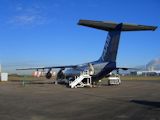
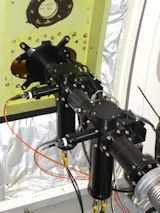
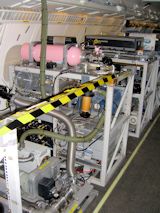
The RONOCO (ROle of Nighttime chemistry in Controlling the Oxidising Capacity of the atmOsphere) campaign is a major UK and international collaboration focussed on understanding the chemistry of the urban troposphere at night.
The AirFAGE instrument was used onboard the FAAM BAe-146 to measure nighttime levels of OH and HO2 over the UK. The FAGE instrument measured on seven flights in July 2010 and 10 flights in January 2011, constituting a total of ~27 hours of HOx data.
Fast processing of HO2 was observed, coinciding with the aircraft passing through the exhaust plumes of ships in the Thames estuary and North Sea, while OH remained below the instrument’s limit of detection during the night-time flights. Studies of the important interactions occurring at night, and their implications for the oxidising capacity of the nighttime atmosphere, have been investigated using box models.
The SeptEx campaign in September 2010 involved daytime, airborne measurements of both HOx species over the UK. Both OH and HO2 were observed, and these data will be used in future modelling studies.
References
Stone, D.; Evans, M. J.; Walker, H. M.; Ingham, T.; Vaughan, S.; Ouyang, B.; Kennedy, O. J.; McLeod, M. W.; Jones, R. L.; Hopkins, J.; Punjabi, S.; Lidster, R.; Hamilton, J. F.; Lee, J. D.; Lewis, A. C.; Carpenter, L. J.; Forster, G.; Oram, D. E.; Reeves, C. E.; Bauguitte, S.; Morgan, W.; Coe, H.; Aruffo, E.; Dari-Salisburgo, C.; Giammaria, F.; Di Carlo, P.; Heard, D. E., Radical chemistry at night: comparisons between observed and modelled HOx, NO3 and N2O5 during the RONOCO project, Atmospheric Chemistry and Physics, 14, 1299-1321, 2014
OP3: Borneo, 2008

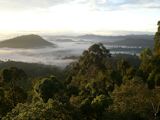
The Oxidant and Particle Photochemical Processes (OP3) campaign took place in Borneo in 2008 and involved both ground based and airborne FAGE instruments. Airborne measurements were timed to coincide with the second ground based measurement campaign and enabled comparison between the composition of air masses over forested regions and farmed regions.
Modelling studies of the observations are in progress, and using current chemical schemes described by the Master Chemical Mechanism (MCM), OH concentrations are vastly underestimated by the model. Recently proposed mechanisms for the OH-initiated oxidation of isoprene are being investigated in the model and may lead to a greater understanding of oxidation processes in low NOx high VOC environments.
AMMA: Africa, 2006

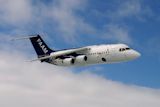
The Leeds AirFAGE instrument made the first measurement of OH and HO2 over West Africa during the African Monsoon Multidisciplinary Analysis (AMMA) campaign during 2006. Measurements were successfully made on 13 flights throughout the campaign, sampling air over ocean, forest, desert and urban regions. Mixing ratios of both OH and HO2 were found to be highly variable, with maximum OH observed at solar noon, while HO2 peaked in the afternoon.
Box modelling studies using the Master Chemical Mechanism (MCM) have been conducted to gain a more complete understanding of the atmospheric chemistry in West Africa.
References
Stone, D.; Evans, M. J.; Commane, R.; Ingham, T.; Floquet, C. F. A.; McQuaid, J. B.; Brookes, D. M.; Monks, P. S.; Purvis, R.; Hamilton, J. F.; Hopkins, J.; Lee, J.; Lewis, A. C.; Stewart, D.; Murphy, J. G.; Mills, G.; Oram, D.; Reeves, C. E.; Heard, D. E., HOx observations over West Africa during AMMA: impact of isoprene and NOx, Atmospheric Chemistry and Physics, 10, 9415-9429, 2010
Commane, R.; Floquet, C. F. A.; Ingham, T.; Stone, D.; Evans, M. J.; Heard, D. E. Observations of OH and HO2 radicals over West Africa, Atmospheric Chemistry and Physics, 10, 8783-8801, 2010
ITOP: Azores, 2004
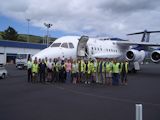
The Intercontinental Transport of Ozone and Precursors (ITOP) campaign was a combined experiment involving four aircraft that aimed to study trans-Atlantic intercontinental transport. The BAe-146 FAAM research aircraft was based on the island of Faial in the Azores and attempted to intersect airmasses from the US that had previously been sampled by US research aircraft upwind. By this method the chemical processing occurring during trans-Atlantic transport could be assessed.
The newly-built aircraft FAGE instrument was first run during the campaign and an OH signal was detected on one flight.
References
Lewis A. C.; Evans, M. J.; Methven, J.; Watson, N.; Lee, J. D.; Hopkins, J. R.; Purvis, R. M.; Arnold, S. R.; McQuaid, J. B.; Whalley, L. K.; Pilling, M. J.; Heard, D. E.; Monks, P. S.; Parker, A. E.; Reeves, C. E.; Oram, D. E.; Mills, G.; Bandy, B. J.; Stewart, D.; Coe, H.; Williams, P.; Crosier, J., Chemical composition observed over the mid-Atlantic and the detection of pollution signatures far from source regions, Journal of Geophysical Research: Atmospheres, 112 (D10), D10S39, 2007
